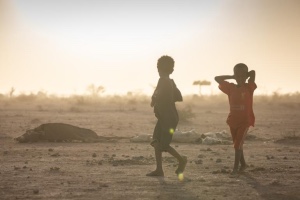
Two boys stand by dead carcasses in Gabi’as village, 23 km northeast of the town of Gode in Ethiopia. Photo ©UNICEF/UN0583951/
Addis Ababa: More than 6.8 million people in Ethipia’s drought-impacted areas of Afar, Oromia, the Southern Nations, Nationalities, and Peoples’ (SNNPR) and Somali regions will be in need of urgent humanitarian assistance by mid-2022, UNICEF has warned.
UNICEF’s drought response appeal for impacted areas in Ethiopia is USD $31 million in addition to the overall humanitarian appeal of USD $351 million. This specific funding will target more than 2 million vulnerable people in Afar, Oromia, SNNPR and Somali regions.
Three consecutive failed rainy seasons have brought on severe drought in these lowland regions, drying up water wells, killing livestock and crops and pushing hundreds of thousands of children and their families to the brink.
“The impact of the drought is devastating,” said Gianfranco Rotigliano, UNICEF Ethiopia Representative. “Children and their families are struggling to survive due to loss of livelihoods and livestock… We are also witnessing major displacement out of affected areas.”
Also read: Fighting in multiple locations affecting humanitarian access in Ethiopia
The most severely impacted regions are the lowland areas of southern and eastern Oromia and Somali regions. There is a significant lack of clean water and the food security is deteriorating rapidly leading to an increase in malnutrition cases.
“In drought-affected areas in Oromia and Somali around 225,000 malnourished children and over 100,000 pregnant and breastfeeding women need urgent nutrition support,” said Rotigliano. “The lack of clean water is further exacerbating the situation for children and women. If children are forced to drink contaminated water, it puts them at risk to various diseases including diarrhoea which is a major cause of deaths among children under five.”
To date, in the drought-impacted areas in Oromia and Somali regions, some 4.4. million people are currently facing critical water shortages.
It is also projected that in 2022, an estimated 850,000 children will be severely malnourished across the four regions due to multiple causes namely conflict, drought, and economic downturn.
Children are also missing out on an education due to the drought. Over 155,000 children in the lowlands of Somali and Oromia regions have dropped out of school so they can help fetch water – often travelling long distances – or look after other children while their caregivers try to find water for their families and cattle. Children who are out of school are at risk of exploitation or are being pushed into dangerous coping mechanisms.
Meanwhile, it may be mentioned that after declaring a state of emergency in November 2021 in face forces from Tigray region had started advancing to the national capital, Addis Ababa, it was on January 26, 2022, that Ethiopia’s cabinet had approved the lifting of emergency in light of changing security conditions in the country. However, people were still fleeing their homes on January 27, due to continued fighting around the town of Abala in Afar province, near the boundary with Tigray province, and the clashes are also preventing the delivery of humanitarian assistance by the only available route into Tigray, with no supplies having arrived there since mid-December.
According to the World Food Programme (WFP), which had a new food security assessment on January 28, 2022, nearly 40 per cent of people in Tigray were suffering from an extreme lack of food, after 15 months of conflict.
– global bihari bureau





